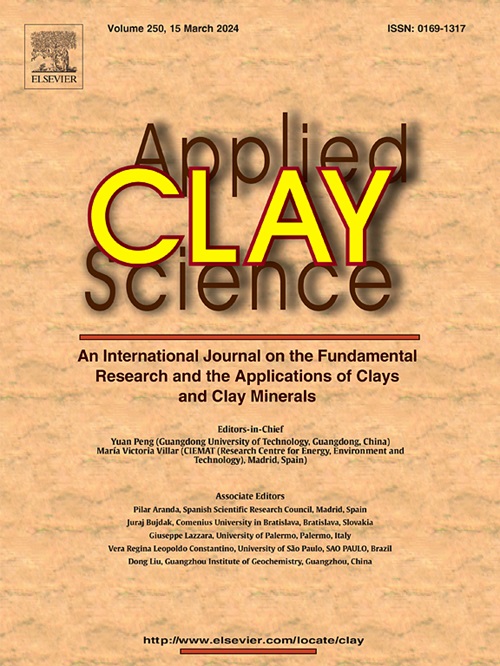流变性能对偏高岭土聚合物动态打印的影响
IF 5.3
2区 地球科学
Q2 CHEMISTRY, PHYSICAL
引用次数: 0
摘要
地聚合物的三维(3D)打印在减少能源消耗和废物产生方面具有相当大的潜力。然而,地聚合过程中材料粘度和弹性的增加会显著影响3D打印过程,如果控制不当,会导致物料流动中断、喷嘴堵塞和滑塌。这些挑战在碱活化的地聚合物体系中尤其普遍,因为它们往往固化得很快。在这项研究中,系统地研究了NaOH(2.5、3.5、4.5和5.5 g)的不同含量与15g硅溶胶的混合对偏高岭土聚合物流变性能的影响。采用benbow - bridge - water模型计算屈服应力和管壁剪应力,并将其纳入Carreau模型,对挤压参数进行优化。为了考虑流变性能的动态变化,在Rhinoceros中开发了一个基于grasshopper的插件,生成g代码文件,用于实时调整关键打印参数,包括层高(0.4-0.8 mm)、打印速度(40-120 mm/s)和挤出压力(50-200 kPa)。实验结果表明,动态参数优化显著提高了打印质量。例如,在Na3.5KL1.2HP0.5 (KL =高岭土和HP =羟丙基甲基纤维素)中堆叠层的数量增加到~ 40层,与使用原始打印方法相比,提高了~ 33%。此外,坍落比提高了5% - 10%,表明在印刷过程中形状保持能力增强。这些发现强调了定制印刷参数对地聚合物流变特性演变的重要性。本文章由计算机程序翻译,如有差异,请以英文原文为准。

Impacts of the rheological performance on dynamic printing of metakaolin-based geopolymer
The three-dimensional (3D) printing of geopolymers has considerable potential for reducing energy consumption and waste material generation. However, the increase in material viscosity and elasticity during geopolymerization significantly affects the 3D printing process, causing material flow interruption, nozzle clogging, and slumping if not properly controlled. These challenges are particularly prevalent in alkali-activated geopolymer systems, which tend to cure rapidly. In this research, the effect of varying contents of NaOH (2.5, 3.5, 4.5, and 5.5 g) mixed with 15 g of a silica sol on the rheological properties of metakaolin-based geopolymers was systematically investigated. The Benbow–Bridgwater model was used to calculate the yield and wall shear stresses, which were incorporated into the Carreau model to optimize the extrusion parameters. To account for the dynamic changes in the rheological performance, a Grasshopper-based plugin in Rhinoceros was developed to generate G-code files for the real-time adjustment of key printing parameters, including the layer height (0.4–0.8 mm), printing speed (40–120 mm/s), and extrusion pressure (50–200 kPa). The experimental results demonstrated that dynamic parameter optimization significantly improved the printing quality. For example, the number of stacked layers in Na3.5KL1.2HP0.5 (KL = kaolin and HP = hydroxypropyl methylcellulose) increased to ∼40, representing ∼33 % improvement compared to that achieved when using the original printing method. Additionally, the slump ratio improved by 5 %–10 %, indicating enhanced shape retention capability during printing. These findings highlight the importance of tailoring printing parameters to the evolving rheological properties of geopolymers.
求助全文
通过发布文献求助,成功后即可免费获取论文全文。
去求助
来源期刊

Applied Clay Science
地学-矿物学
CiteScore
10.30
自引率
10.70%
发文量
289
审稿时长
39 days
期刊介绍:
Applied Clay Science aims to be an international journal attracting high quality scientific papers on clays and clay minerals, including research papers, reviews, and technical notes. The journal covers typical subjects of Fundamental and Applied Clay Science such as:
• Synthesis and purification
• Structural, crystallographic and mineralogical properties of clays and clay minerals
• Thermal properties of clays and clay minerals
• Physico-chemical properties including i) surface and interface properties; ii) thermodynamic properties; iii) mechanical properties
• Interaction with water, with polar and apolar molecules
• Colloidal properties and rheology
• Adsorption, Intercalation, Ionic exchange
• Genesis and deposits of clay minerals
• Geology and geochemistry of clays
• Modification of clays and clay minerals properties by thermal and physical treatments
• Modification by chemical treatments with organic and inorganic molecules(organoclays, pillared clays)
• Modification by biological microorganisms. etc...
 求助内容:
求助内容: 应助结果提醒方式:
应助结果提醒方式:


